
6 Writers: Eiichiro Oda
July 16th, 2010 by david brothers | Tags: 4321, eiichiro oda, one piece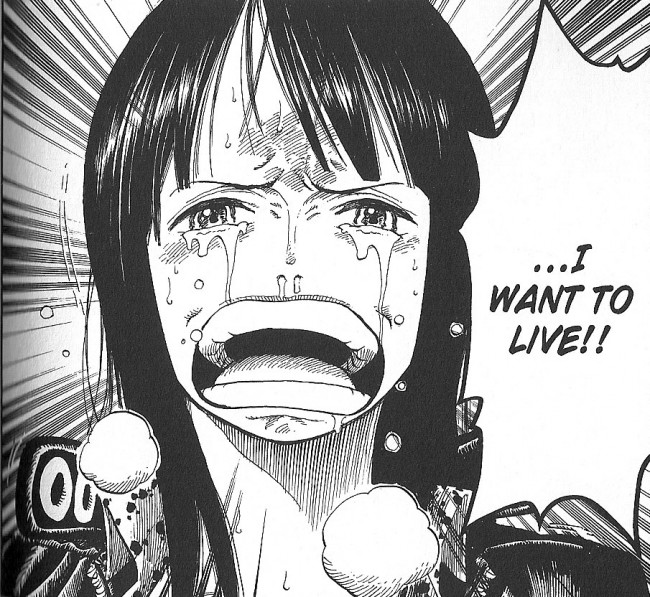
 Emotional trauma makes for good backstory, doesn’t it?
Emotional trauma makes for good backstory, doesn’t it?
The cast of Eiichiro Oda’s One Piece certainly seems to be proof positive. All nine crew members have some kind of significant traumatic moment in their life that set them on their current path. The severity of the moment varies. Sometimes it’s a friend sacrificing a limb (two crew members), sometimes it’s the death of a family member (two), sometimes it’s having your entire hometown wiped off the face of the map (one), or sometimes just the death of a good friend or six (three).
Tragic pasts quickly become old hat and boring if you read comics for any length of time. For some reason, though, it just works in One Piece. You can’t get enough. They’re spread out far enough, and executed well enough, to be interesting, instead of trite. They’re also a signifier that a character has finally become a true member of the crew, rather than just a guest star. So, how has a series with no less than eight tragic pasts (if you want to quibble over Luffy’s origin) not turned into cheap soap opera?
Rather than leading with the tragic past, like you’d see in your average superhero comic, Oda keeps it in his pocket for later. It puts me in mind of the process you go through when making new friends. The first few weeks are the probationary period, where you just kinda hang out and have fun and don’t get too deep into things. After a while, though, your guard is lowered. You’re hanging out, you’re used to each other, and you share a little more than you normally would. After that, you begin sharing embarrassing things, and eventually, things that scare or bother you. By that point, you’re on together forever status. You’re trusting someone with your innermost thoughts, the sort of thing you keep walled up deep inside your head.
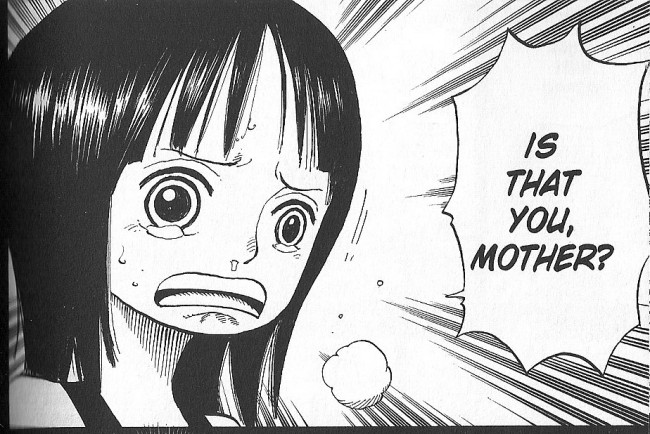
In real life, you get to know someone’s laugh before you get to know their tears. One Piece follows a similar arc. Characters are introduced, we get a good grasp on their personality, and then later, when it becomes relevant, bam, we get to see that little bit of ice that sits deep in their heart. Sometimes it’s just relevant and not too tear-jerking, like Sanji’s tale of the time a dude nearly starved to death to save his life. Sometimes it’s really, really sad, the sort of thing you avoid reading on a bus because then you look like a crazy person. Sometimes, it’s a complete and utter emotional apocalypse.
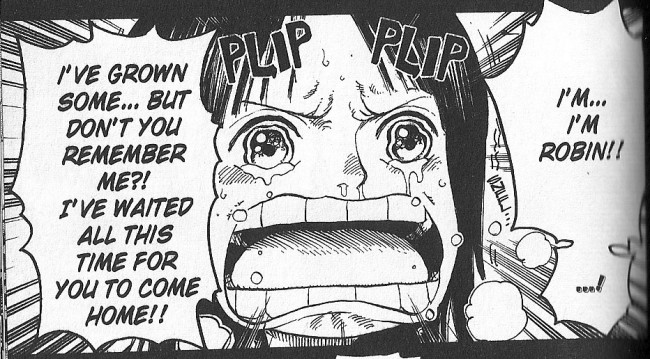
The flashbacks to the past are always relevant, too. They aren’t just thrown into the mix just for cheap heat. When we find out exactly why Nico Robin has been on the run, it’s because her past has finally caught up to her. When we find out why Nami has been a thief for the past few years, it’s because she can’t bear that burden alone any longer. It’s always something that either sheds greater light on the story at hand or something that moves the plot itself along.
This technique has worked out wonderfully for Oda and One Piece. Characters are defined by their dreams first, whether that’s becoming king of the pirates or finding the sea where all the fish in the world congregate. When the tragic history comes in, it adds further depth, rather than creating their entire reason for going on adventures. It’s extra context for a character you already enjoy, helping that character to be just that much more well-rounded.
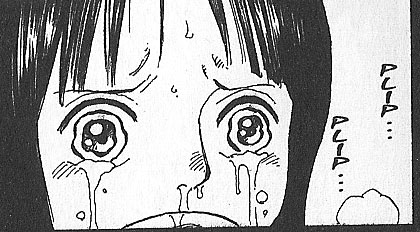
It’s fair to say that One Piece is a happy manga. It’s about friendship and adventure and beating up bad guys. This doesn’t stop it from having a certain amount of depth of character, though. None of the characters, barring idiot Luffy, are just happy. Several of them needed a breakthrough before they became happy or learned to trust people. While you’ll come across emotional landmines every once and a while, the overall mood of One Piece is a very well rounded one. Oda can flip from happy to sad and back again without breaking the book.
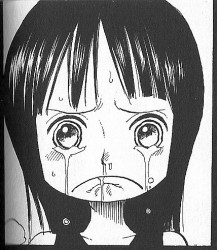
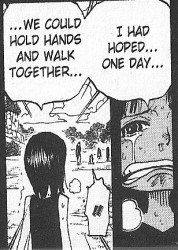
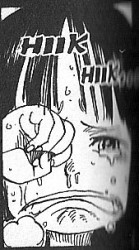
Oda is over 50 volumes deep and creeping up on 600 chapters in a series that is extraordinarily character-driven for a manga of its genre. The action is good, and the jokes are pretty funny, but the real meat and potatoes of the book is the way the characters act and interact. Oda keeps ringing the Sad Backstory Bell, but for some reason, it gets better and better every time. It never becomes trite or boring or pat. By delaying the big emotional breakdown, by pushing the tragic past off until he absolutely has to bring it up, he manages to make the impact that much more powerful. This is killer writing, and I hadn’t expected to see something so grown-up, albeit wildly exaggerated on occasion, in a kids’ manga.












At its worst, One Piece is just pretty good. At its best, it’ll leave you a stupid blubbery mess in public.
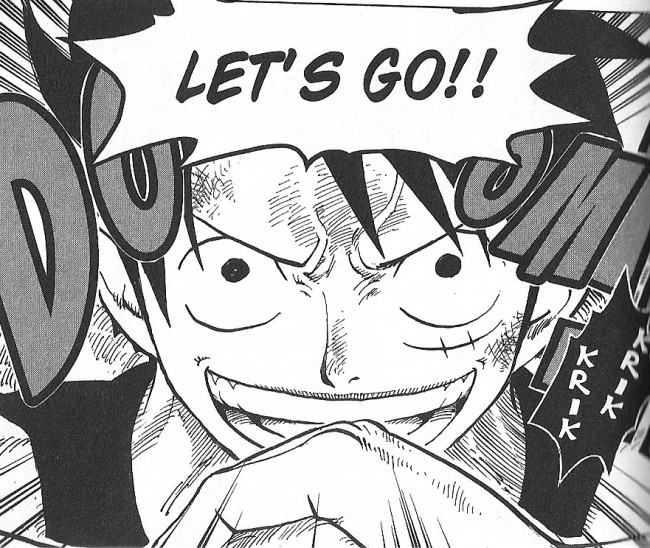

A friend of mine once posited that the reason the art was so extreme was to distract the young male audience from the incredibly emotional and character-driven story.
> At its worst, One Piece is just pretty good. At its best, it’ll leave you a stupid blubbery mess in public.
Agreed.
@Erica: I could totally buy that theory. It looks like a cartoon, like the bastard child of Tex Avery and Akira Toriyama. There are several scenes where someone’s eyes bug out of their skull (or sometimes their eyes and teeth completely separate, like Usopp in Skypeia) and I just laugh and laugh every time. There’s definitely an expectation set up by the art (“This is going to be goofy and fun”) which is then upended by the story (“Labooooon!”).
I didn’t mention it here, but I like how Oda approaches romance, too. It’s either completely overplayed and ridiculous, as in Sanji and Boa Hancock, or essentially nonexistent. It’s always done for laughs, rather than really drawn out X-Men-style soap opera.
That first panel is uglier than anything rob liefeld ever drew.
Oda has talked about that and people are never composed or look their best when they’re crying so the way it is overblown really helps to convey that, at least for me.
@Rick: No, it totally works. Oda also gets one thing dead on that a lot of artists (and pretty much no movie) don’t with regards to crying–snot. If you ever have a real deal crying jag, your nose is a complete mess. Having that little bit of dribble adds a lot of (i’m so sorry in advance) flavor.
@steve: Rob Liefeld jokes is all you got? Step your game up, man. Those are the “What’s the deal with airline peanuts?!” of comics commentary. Trite, lame, not even interesting… try again, kid.
all in all shanks is prob my second fav character
next to the man himself, LUFFY
From 6 Writers: Jeff Parker “(This is the third writer in a row I’ve written about who is also an artist.)”
You’re 5 for 5 now, Brothers. Think there’s something to that? Might could squeeze another article out of it, even.
As for what the other Steve said, I’d say that if it’s ugly at all it’s a stylistic choice to portray mood. There’s ugly art (Liefeld), and then there’s ugly art (I’m thinking Guy Davis here).
One Piece really deserves its position as the best selling manga in Japan, the way the series so deftly weaves all the best elements of the manga genre together with an injection of zany originality (seriously, if you’re fed up with generic fight scenes check out One Piece).
@Steven: Once I realized I’d done three in a row, I just accepted my fate and switched up the back end of the week so that all 6 Writers are going to be cartoonists. Though, in my defense, I’m speaking strictly to their writing here!
And you’re right. Richard Corben, Doug Mahnke, Guy Davis, Duncan Fegredo, and Alberto Ponticelli all draw ugly, but in a fantastic and completely pleasing way.
Luffy’s back story got expanded on recently. He doesn’t miss the boat.
@david brothers: So if Liefeld is the “Airline Peanuts” joke I’m gonna assume that “Batman and Robin are Gay!” and “Superman is a dick!” and “Nobody ever stays dead in comics!” are the “Chicken Crossing the Road” gags, except even less funny or relevant.
David, I’m not a kid and I wasn’t making a joke.
Personally, one of the things that impresses me about Oda is his attention to detail. Things you think are throw-away or that have been forgotten turn out to be important to the story. Characters you think will never be seen again not only come back, but do so in ways you don’t expect. I especially like how he uses title page illustrations to give readers a window into what’s going on with these characters we haven’t seen in a while. How many people over ten years ago would have expected a wacky story about a pirate who can stretch like rubber to have turned out to have such a tightly woven plot?
@Jordan: “Batman and Robin are gay” jokes are the “That’s what she said,” I’d say, otherwise you’re spot on.
@Gaijin D: Buggy the Clown alone is a fantastic character, but the work Oda put in on Bon Clay is amazing. I love that guy.
First off: that hanging out analogy is rock solid. Kinda blew my mind there.
Second: One of the things that also keeps the tragic flashbacks fresh is that Oda always steps up his sequential art game on them.
I mean, that stack of payoffs in the Nami sequence (the payoff is Nami asking for help…no wait, it’s the splash of Luffy BELLOWING “Okay!”…no wait, it’s the pan back to reveal that the rest of the crew’s been there THE WHOLE TIME and is ready to wreck some shit) is above and beyond what most cartoonists, Oda included, pull out in the average installment. It makes the emotional payoff that much stronger.
God, no one does crying people like this guy. You just feel so damn sorry for these characters yelling in sheer petulant distress. This is the essence of bawling.
Goddamnit, just reading the last 5 full pages you posted made tears come to my eyes.
[…] been posting articles about six of his favorite comic writers. Among his choices: Naoki Urasawa, Eiichiro Oda, Inio Asano, and Stan Sakai. Each essay explores key themes in the artist’s work, from the […]
@ Steven
I’m totally stealing that line about art and ugly the first chance I get. Well said sir.
[…] 4thletter!, David Brothers has posted insightful illustrated essays on manga creators Eiichiro Oda and Inio Asano, focusing on their work as […]
Great post, completely agree.
Dammit, DB. Nami’s BSOD is what addicted me to One Piece. Now, manly tears are pouring out of my eyes again…